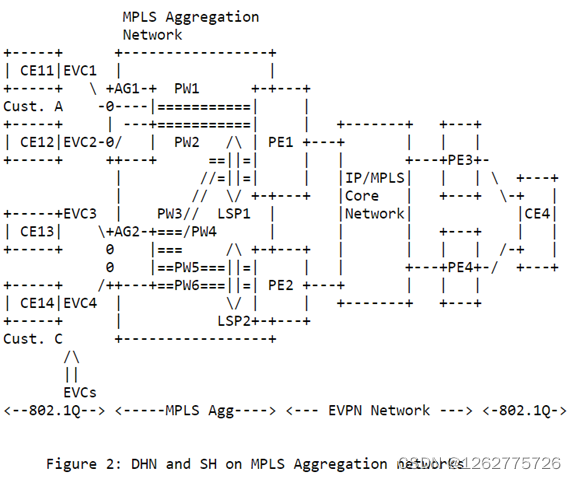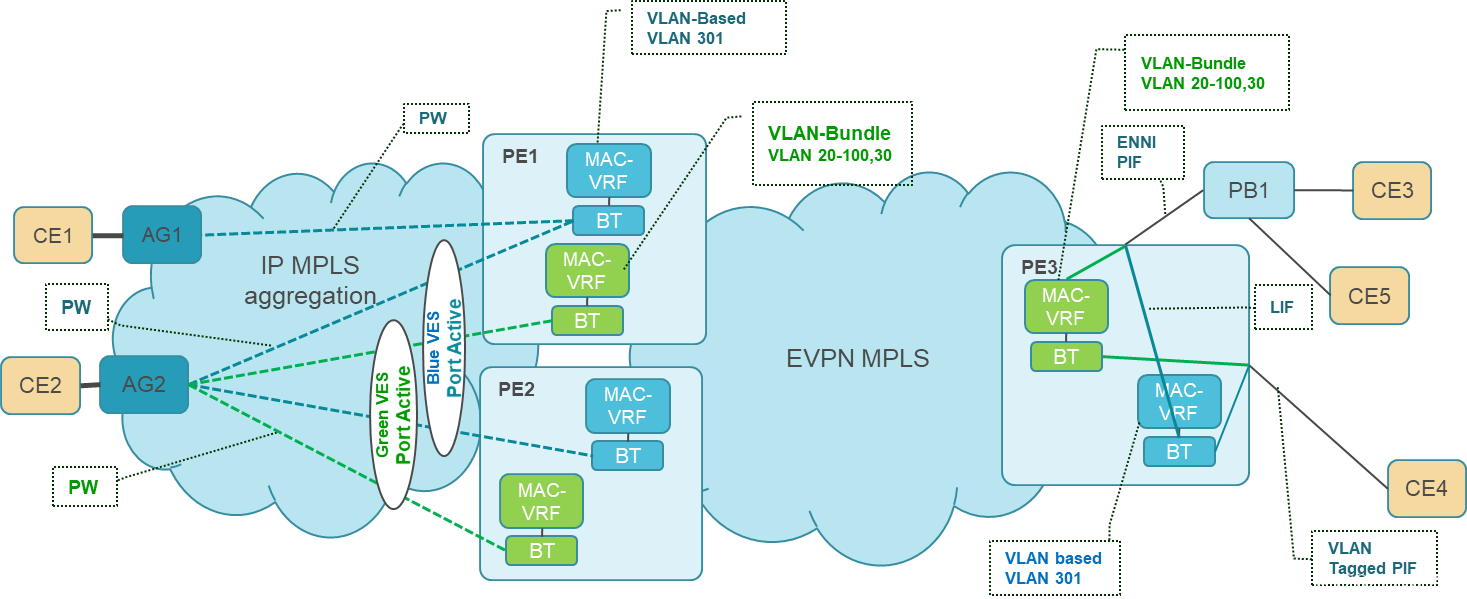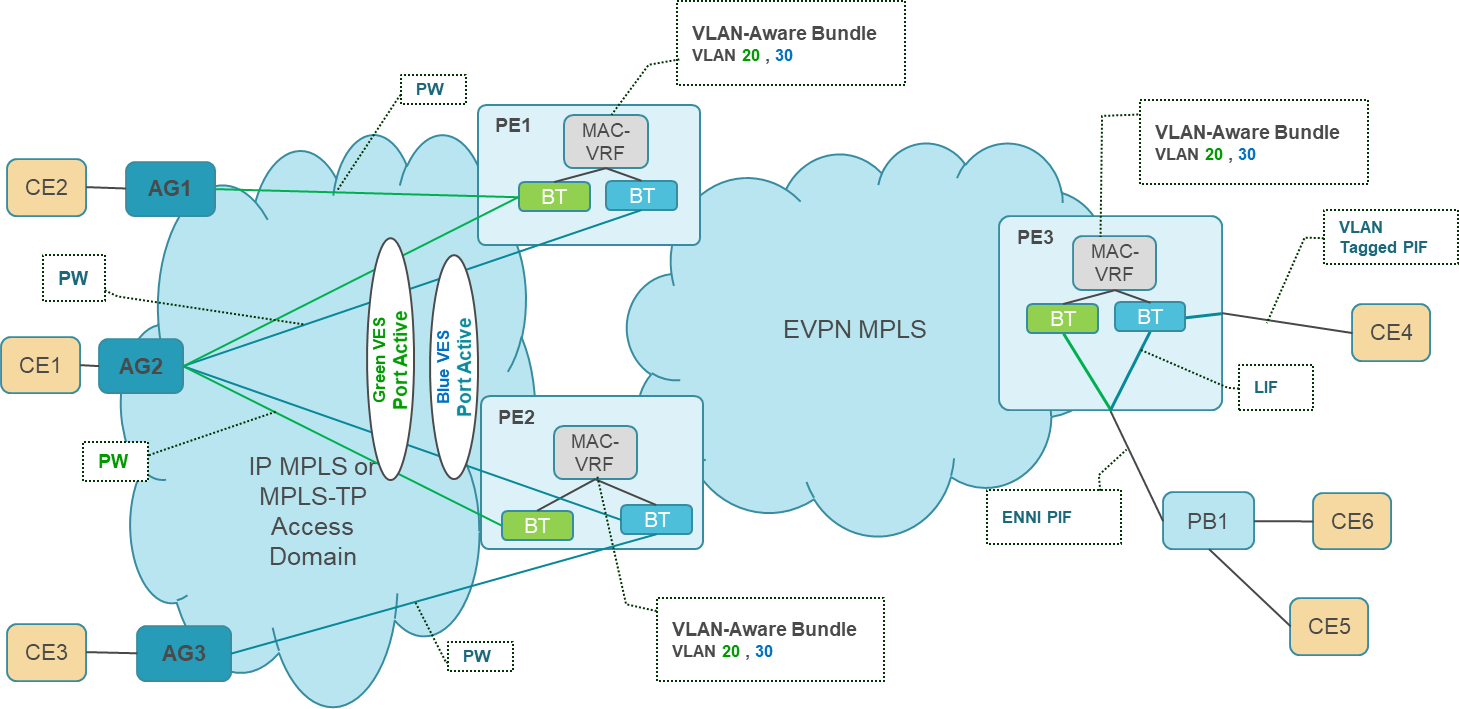Introduction
Purpose and Scope of the document
This document specifies the system functional requirements for supporting EVPN Virtual Ethernet Segments (vES) as yet another dimension(方面) for EVPN Multipoint and EVPN-VPWS services that is aimed to enable the connection of remote CE devices to EVPN services deployed on an EVPN-MPLS domain through IP MPLS Access/Aggregation domains that do not support EVPN.
The standard draft discusses two major types of Ethernet Virtual Circuits (EVC) , both of which connect the CE device specific L2 service to the EVPN-MPLS domain PE devices via an access/aggregation MPLS or Carrier Ethernet Network domain that do not support EVPN.
Two major types of those Ethernet Virtual Circuits are:
PW (or LSP): in which the EVC is a PW between the CE and the EVPN-MPLS core PE. The PW is either tLDP signaled or non-signaled PW over signaled MPLS / MPLS-TP aggregation domain accordingly.
In this case the virtual segments connections may also be an LSP (in case the CE device is connected via multiple PWs over LSP to the PE device).
VLAN or SVLAN EVC: where the EVC between the CE devices to the EVPN service PE ENNI port is a specific VLAN, say S-VLAN, through a 802.1Q aggregation domain.

General Description
Brief Feature Description
The notion(概念) of Virtual Ethernet Segment leverages(充分利用) all the EVPN functionality described in RFC7432 as is with the major change that ESI assignment is performed for Ethernet Virtual Circuits or Pseudowires instead of physical links.
The purpose of supporting PW Virtual Ethernet Segment is to enable connect CEs that are not directly connected to the MPLS domain on which the EVPN services are deployed. Those CEs are connected to access/aggregation MPLS domains that do not support EVPN.
As noted above, those Access/aggregation MPLS domains may either be non-signaled MPLS-TP domains or signaled IP-MPLS domains through which the PWs are paved between the remote CEs and the EVPN capable PE devices.
The vES PWs are statically configured on the MPLS-TP or dynamically signaled via tLDP between the CE and the EVPN IP-MPLS PE device.
The below major use cases introduce the use cases to be supported in 9.0:
Major use case #1: SH/MH PW vES for EVPN-VPWS
In the below diagram a static PW interconnects the CE device to the EVPN-VPWS Service on the IP-MPLS domain over an MPLS-TP access domain:

Major use case #2: SH/MH PW vES for Multipoint EVPN services for mobile MPLS-TP or IP-MPLS aggregation/Access network
The below diagram shows several base station CEs, each of which is dual-homed to two EVPN multipoint service PEs via two PWs forming MH-vES. The MH Type in all three MH vES is Port-Active.

Each of the three base-station CE devices is dual homed to the EVPN capable IP-MPLS domain Provider Edge devices PE1 and PE2.
Three multi-homed Virtual Ethernet Segments are defined on each of PE1 and PE2 related EVI MAC-VRF. Note, while the draft allows support of All-Active and Single-Active multi-homing vES the MKT requires the support of Port-Active Multi-homing mode only.
The three dual-homed vESs are defined on PE1 and PE2 with PW VES supporting Object, in our case this will be a VES Logical Interface of type PW-VES. The MH-Type of his vES is defined as Port-Active. The configured ESI type and ESI value of this VES should either be 0 (unique user defined ) or 3 (MAC address).
PW Virtual Ethernet Segments under various EVPN Multipoint services
The below diagram illustrate SH and MH PW vES in the case of VLAN based and VLAN Bundle services:
A VLAN based EVI MAC-VRF with a single Broadcast Domain has a PW VES interface connected to CE1 and a second PW VES connected to CE2, which is multi-homed to PE2 as well.
The VLAN-Bundle service MAC-VRF both on PE1 and PE2, both of which are dual homed to CE2 via two PW VES interfaces that are connected to the related VLAN-Bundle service single Broadcast domain on each of the PEs.

The below figure depicts VLAN-Aware bundle service MAC-VRF on PE1 and PE2 with two VLANs i.e. Broadcast Domains (GREEN and BLUE BDs) each of which has a single PW VES to CE1, both of which form two dual homed PW vES from CE1 to PE1 and PE2. The GREEN BD on PE1 MAC-VRF has another PW VES interface (a single homes PW VES) to CE2. The BLUE BD on PE2 MAC-VRF has another PW VES interface that interconnects it to CE3.

The figure below illustrates a EVPN-VPWS service between CE1 and CE4 where CE1 is dual homed to EVPN-MPLS domain PE1 and PE2 devices via dual homed PW vES over the non-EVPN capable IP-MPLS aggregation network.

General System Requirements
Supporting PW Virtual Ethernet Segment mainly involves the following major requirement realms:
Virtual Ethernet Segment Configuration requirements:
Configuration of a new type of L2 LIF: the PW Virtual Ethernet Segment L2 logical interface, on which the PW related parameters are configured.
Ethernet Segment configuration change that includes the configuration VES interface as supporting interface.
Configuring the related interfaces on the related EVPN Multipoint service MAC-VRF or EVPN-VPWS service.
The above includes the related configuration validations.
Control plane behavioral requirements:
Port Active MH requirements applies also to PW vES use case; among the related configuration we determine:
The need for a standby PE to advertise the per-ESI route type 1 when the PW status is standby (I.e. not active).
The need to activate the standby PW upon failure of the Primary side PW or related physical ports.
The need to support preference based DF election for PW vES as defined in the Port-Active Multi-homing SRQ in order to enable customer control of the Active port.
The need to support Protected single homed PW via the usage of a PW-R pair.
Interoperability
EVPN-VES-Interoperability-Req #1: MH vES Interoperability with the following vendors should be tested for all EVPN Multipoint services supported on v9.0 but only for the Port-Active mode.
Interoperability with Cisco: Looking at the Cisco support for vES there is a clear indication that Cisco only support Single Active mode for PW vES. However under PW VES we should assume that Port Active is similar to Single-Active. We shall therefore test our Port-based MH PW vES implementation with Cisco’s Single-Active MH vES.
MH vES interoperability with the following Vendors is optional: (The Reason being that at the time this SRQ is being written There is no equivalent support of either Virtual Ethernet Segment or lack of support in PW vES.)
Interoperability with Juniper: As per Juniper EVPN Multi-homing support document : there is no mentioning of vES support. Not to mention PW vES. In case a new JUNOS release that supports EVPN PW vES will be release we shall test interoperability with it.
Interoperability with Nokia: According to the Nokia Support of VES paper there is no PW vES support. Only the below (star) vES interface types are supported. Should there will be a new NOKIA release that supports PW vES we should test interoperability with Nokia:
(star) Nokia supported vES can be associated with either of the following:
Q-tag-ranges on dot1q ports or LAGs
S-tag-ranges on qinq ports or LAGs
C-tag-ranges per s-tag on qinq ports or LAGs
VC-ID ranges on SDPs
Relationships with Other Features/Equipment
The requirement for PW Virtual Ethernet Segment applies to the following EVPN major features:
PW-Virtual-Ethernet-segment-EVPN-Multipoint-Services#1: PW VES support for VLAN-Based, VLAN-Bundle and VLAN Aware Bundle services.
EVPN PW Virtual Ethernet Segment must support work with all Multipoint EVPN services including VLAN-Based, VLAN-Bundle and VLAN Aware Bundle services.
Note! There is no indication of the VLAN tagging of packets over the related PW VES, and the operator is assumed to make sure that the proper VLAN tagged packets are populating the related PW VES.
There is no support for VLAN translation on the egress the user is therefore assumed to have validated that such egress translation is not required. (In VLAN Bundle there is anyway no need for VLAN translation.
All the related VLAN-Based, VLAN-Bundle and VLAN-Aware services requirements apply to the PW VES apart of those parts that relate specifically to the usage of VLAN Tagged AC based single homed and multi-homed ES.
PW-Virtual-Ethernet-segment-EVPN-VPWS-Service#1: EVPN PW Virtual Ethernet Segment supported for EVPN-VPWS:
EVPN PW Virtual Ethernet Segment must be supported with EVPN-VPWS.
Note! There is no indication of the VLAN tagging of packets over the related PW VES, and the operator is assumed to make sure that the proper VLAN tagged packets are populating the related PW VES
All the related EVPN-VPWS requirements apply to the PW VES apart of those parts that relate specifically to the usage of VLAN Tagged AC based single homed and multi-homed ES.
MH type for PW Virtual Ethernet Segment: As indicated in the configuration validation requirement PW VES Multi Homing MUST is limited to Port-Active MH type only.























 546
546











 被折叠的 条评论
为什么被折叠?
被折叠的 条评论
为什么被折叠?








